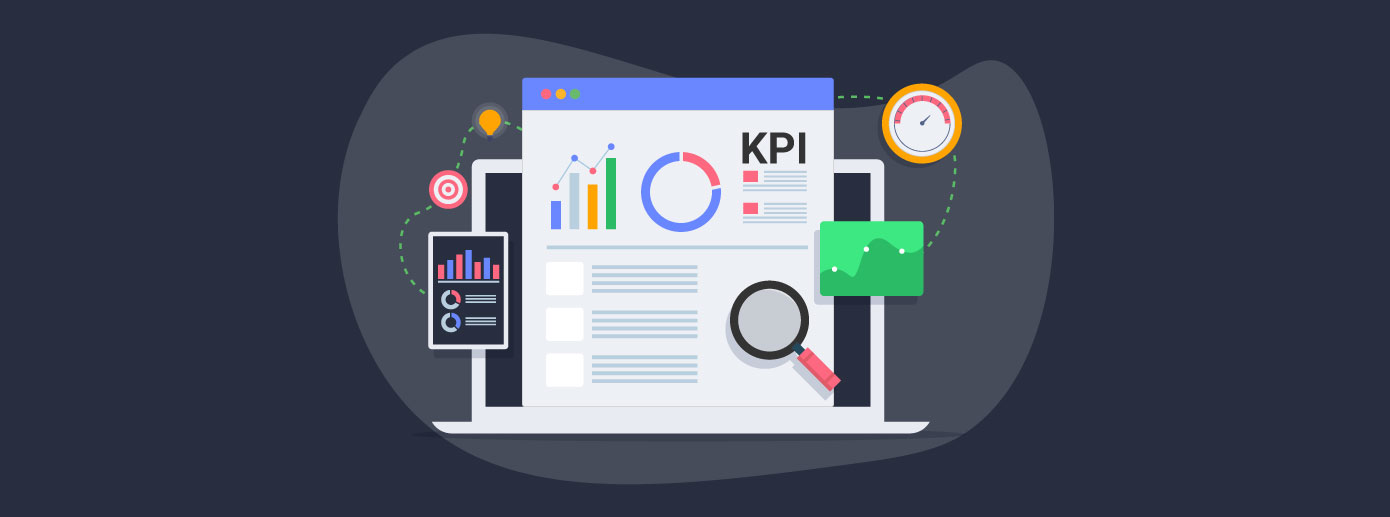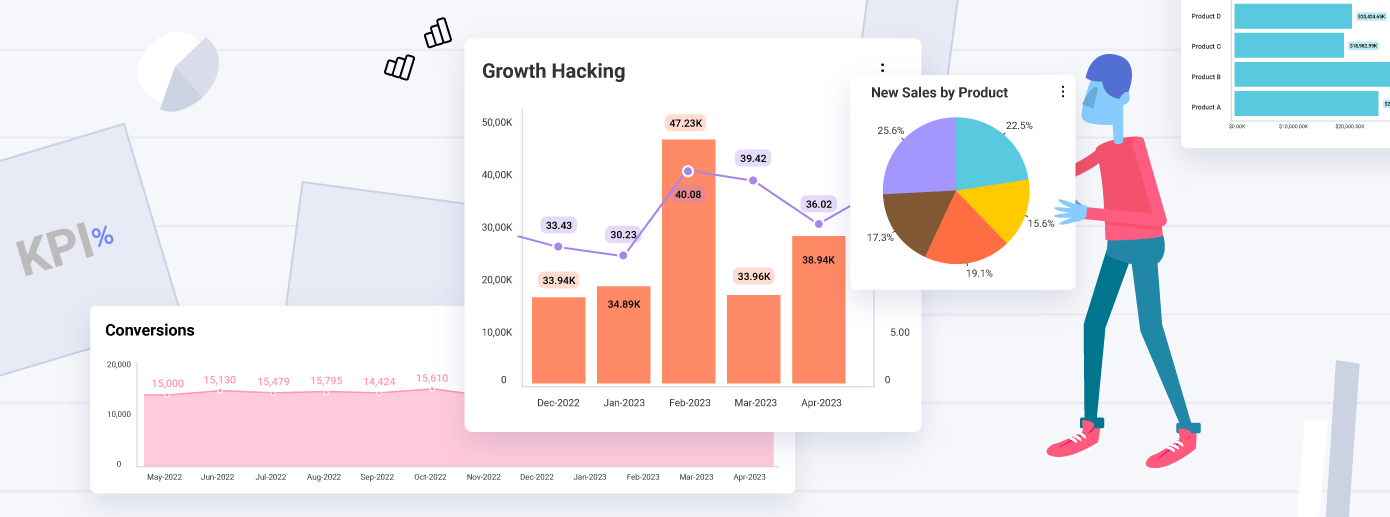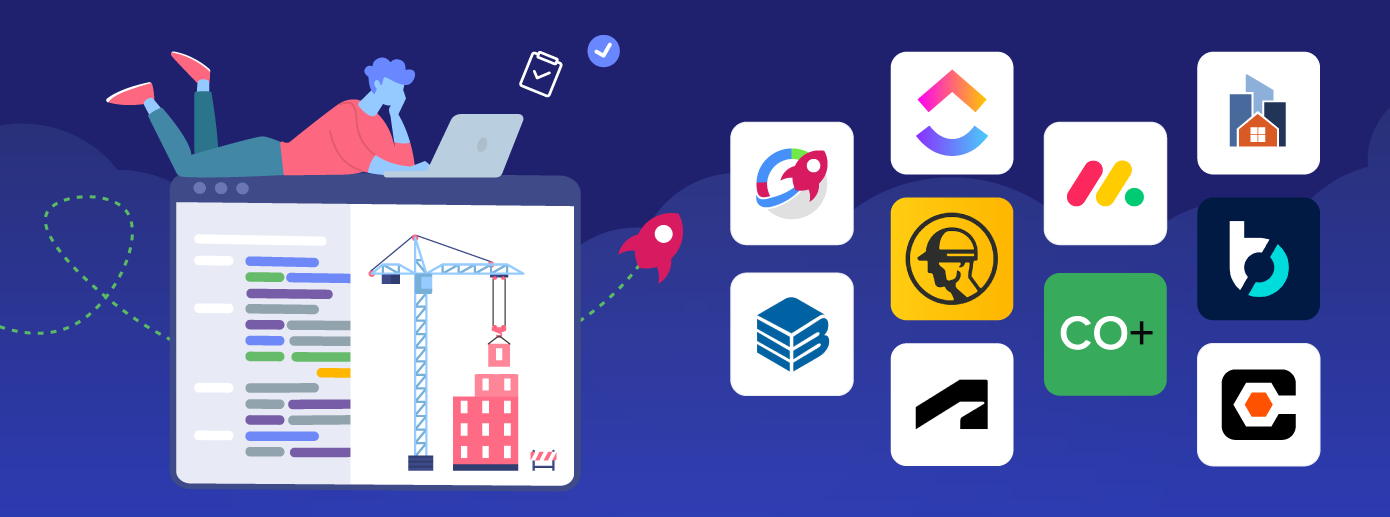
What Is Self-Service BI & What Are Its Benefits?
With self-service BI implemented within your work management interface, data-driven decisions are no longer a luxury. They become the basis of your entire operation—from the CEO's company-wide decisions to project managers' task assignments and the everyday efforts of each team member.
Executive Summary:
With self-service BI implemented within your work management interface, data-driven decisions are no longer a luxury. They become the basis of your entire operation—from the CEO's company-wide decisions to project managers' task assignments and the everyday efforts of each team member.
As companies grow, so does their data generation and collection. This digitalized information, however, has value only if stakeholders can utilize it at the right moment. This is the tricky part. Fortunately, this is where self-service business intelligence (BI) shines.
The collected data must be translated into a comprehensive and easily digestible form. This was hardly an issue for many companies, as they involved IT and BI experts in doing the work. However, in these businesses, data is reserved only for C-level executives, who make company-wide decisions.
Our recent study perfectly illustrates the problems with such practices. Only 23% of employees know what the company’s goals are. This results in poor prioritizing, frustration, and lack of motivation. Moreover, 72% of employees are adamant that their productivity depends on various metrics related to their role.
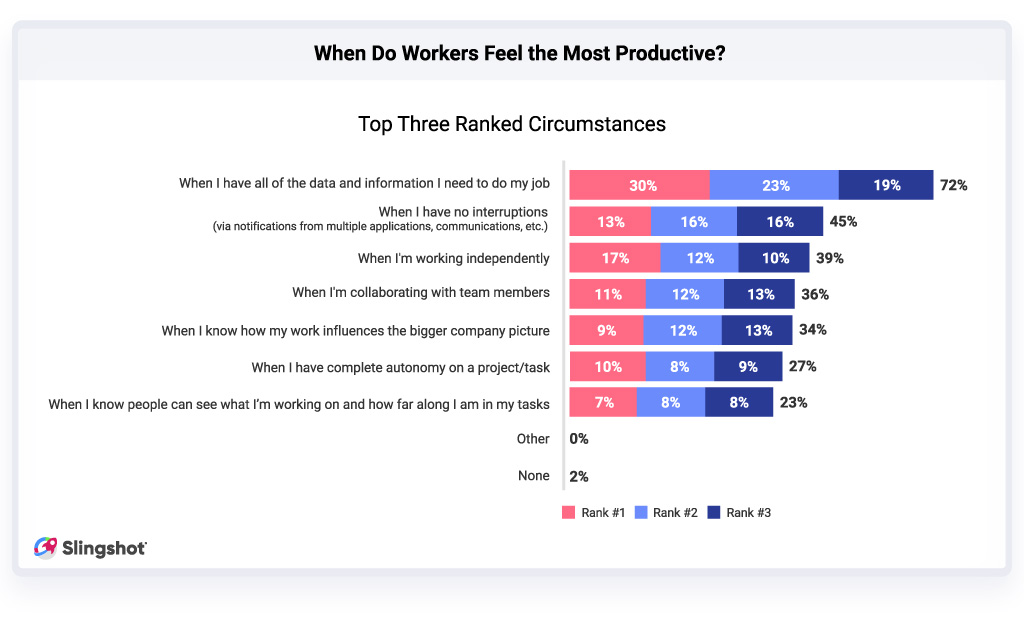
So, giving everyone access to the same data source and allowing them to draw the information they need freely is the backbone of sustainable growth.
Self-service BI is the answer to your problems. So, let’s discuss the what, why, and how of self-service business intelligence.
What Is Self-Service BI?
Self-service BI refers to the process, tools, and software that empower end users to analyze large amounts of business data and build dashboards independently. The traditional method, involving BI experts and the IT team, is far from optimal. It’s sluggish, complex, and resource-heavy.
Thus, non-tech-savvy users like marketers, project managers, and sales representatives can’t benefit from the enormous data silos each business has. As a result, they are forced to make decisions based on their intuition and experience, significantly increasing the chance of mistakes.
Self-service BI allows everyone within your company to create reports according to their needs. They don’t need complex IT, design, or data analytics know-how. A good self-service BI tool will generate data visualization for them.
It’s a win-win solution for everyone within your organization. On the one hand, users get the data they require, rendering them more productive and capable of making better-informed decisions. On the other, you don’t need a dedicated IT team. Thus, your entire workforce can focus on more valuable tasks..
Traditional BI vs Self-Service BI
While self-service business intelligence allows end-users to turn data insights into resources, the IT team or dedicated BI experts own the traditional BI operations. They convert the raw data into resources, fueling intelligent business decisions.
This means that when users need specific reports or dashboards, they must request them and wait for the IT team or BI experts to deliver the data. This process often takes hours, if not days.
Of course, this inefficiency causes employees frustration and delays in providing the information needed for data-driven decision-making. As a result, managers often rely on instinct or simply miss out on opportunities.
In contrast, self-service BI tools provide intuitive UI that makes interacting with data more accessible for those who don’t have technical knowledge. It allows everyone within your organization to access and analyze data easily and create reports with actionable insights that anyone can understand.
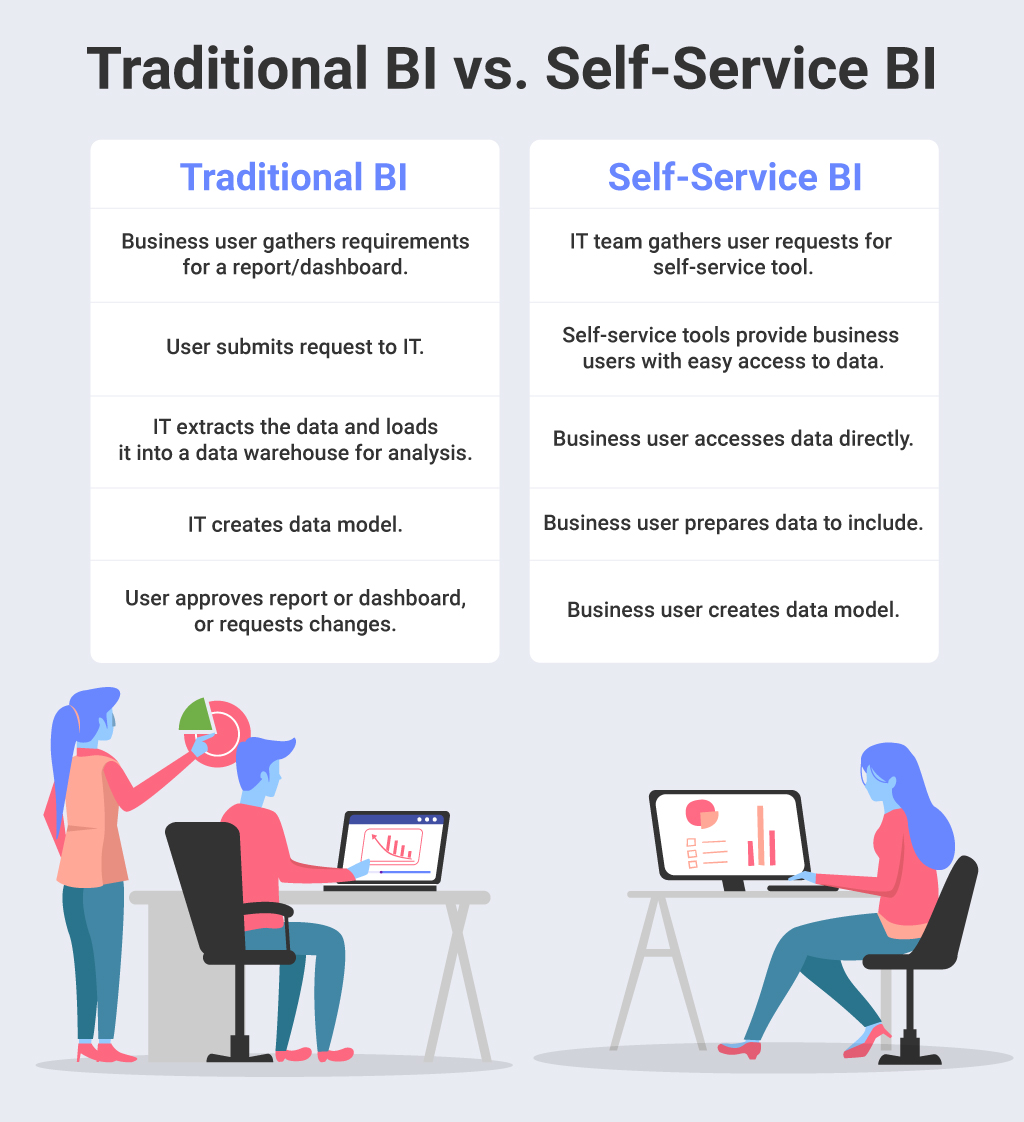
What Are the Benefits of Self-Service BI in Your Digital Workplace Management Software?
In 2020, self-service BI was considered the 6th most important technology. Unsurprisingly, its role today is even more indispensable, especially when combined with user-friendly digital workplace management software.
The digital workplace management software combines various tools and technologies needed to effectively run your team and achieve success from anywhere, anytime, in a secure environment.
So, having your self-service BI solution in your management tool will instantly boost productivity and skyrocket results.
This is just a tiny part of the numerous benefits self-service BI will bring your business.
Better Use of Company Resources
Using self-service business intelligence will free a significant company resource. On the one hand, there will be no need for a dedicated IT team or BI specialists to create data visualizations. This will allow them to devote their time to more valuable projects.
On the other hand, users will have faster access to data, saving time and effort when making decisions or doing their tasks.
If your self-service BI is AI-powered, your teams can save up to 4 hours, reducing the overall workflow lag. Furthermore, 54% of employees share that they use the saved time to re-prioritize and manage their workload more efficiently.
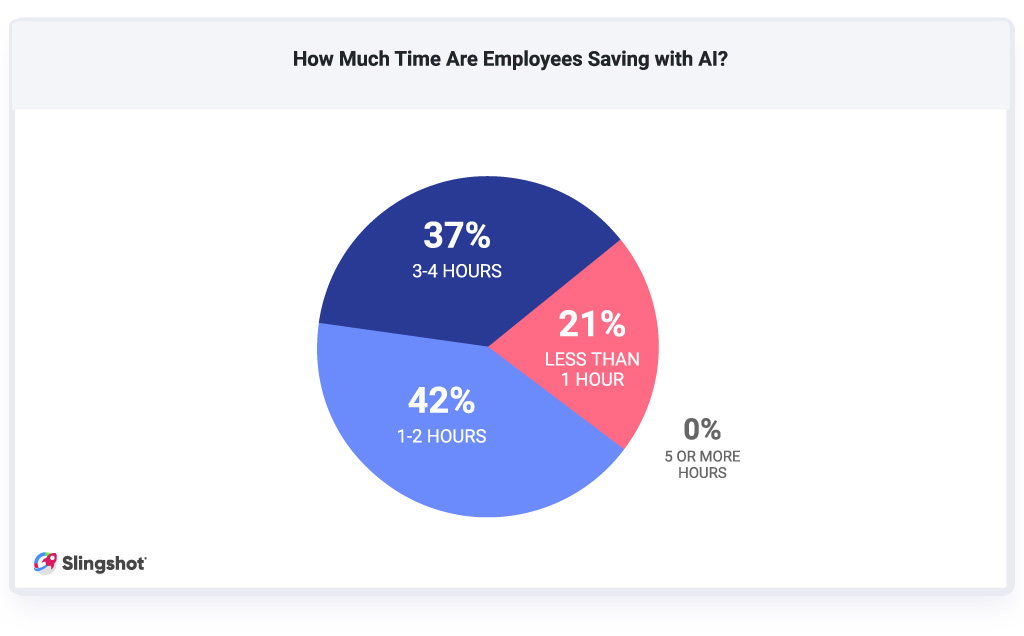
Allows Deeper Dive by Non-Tech Users
Self-service BI also allows non-tech users to have a more in-depth look into the data they need. Traditional BI restricts end users to linear, query-based analysis. This limits professionals to exploring alone and finding more relevant data independently.
To allow its professionals to investigate data as they need, without complete technical knowledge, companies must implement self-service business intelligence. Naturally, this leads to better results, smarter solutions to current problems, and data-driven ideas on how they can be more productive.
Improves the Decision-Making Process
The primary mission of BI is to help organizations streamline their businesses by connecting people to the data they need to make important decisions.
With self-service BI, users no longer need to waste time trying to analyze spreadsheets to source their data and make gut-based decisions. Instead, they have more time to focus on it. Its dashboards, reports, and visualizations make the decision-making process effortless and effective. Ultimately, it makes the decisions better, smarter, and, most importantly, data-driven.
Leverage Actionable Insights
Everyone on your team, in every department, can easily access and analyze key data. Marketers can investigate their customer’s data to understand their needs better. The HR department can research data to improve the workplace or enhance recruitment. CFOs and financial managers can build and share meaningful financial reports quickly.
With the help of self-service BI tools, end users can visualize the data they need and understand what it means. Leveraging actionable insights makes it easier for your team to utilize data. This improves the productivity flows and makes the process of going from insights to action seamless.
Enables Collaboration
Self-service BI tools also foster seamless collaboration among team members and between the different teams. This is a result of the shared dashboards that the teams use. Thus, everyone is on the same page all the time—from the decision-making all the way to the execution.
This collaboration enables teams to share thoughts and ideas.
It also allows team members to become more invested in the outcome of the entire project, not just their tasks.
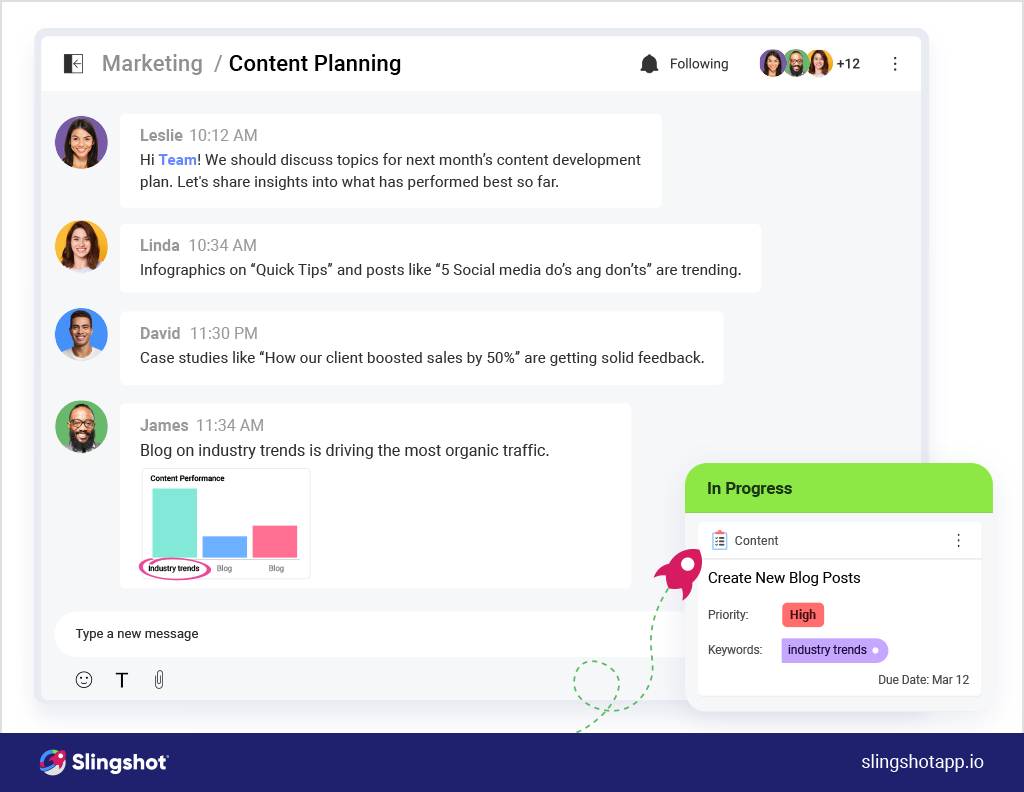
A well-organized self-service BI integrated into your digital workplace will allow each team member to see precisely what their contribution to the overall success is. This is invaluable for motivating team members and fostering company loyalty.
Furthermore, problems are more easily detected and fixed. When your entire team is involved, each member can notice and report a problem. Moreover, with a centralized system, the reporting-to-fix time is significantly decreased.
Simplifies the Daily Workflow
When self-service BI is implemented in your digital workplace management software, everyone within your team can effortlessly create tasks based on actual data-proven needs.
For example, if sales drop after the release of a test orchestrated by the growth hacking team, it may indicate that the new landing page sends leads with poorer quality. This needs intervention from both the copy and design teams.
So, the sales manager can create a task directly from the same dashboard and involve copywriters and designers with a couple of clicks, providing flexible data they can manipulate to discover the problems on their end.
Without such a solution, your entire team’s productivity will suffer significantly. Our 2023 survey on managing work shows that a quarter of all employees claim that gathering information and working with multiple software solutions is their biggest challenge. Furthermore, according to 50% of employees, an all-in-one solution will significantly improve their workflow.
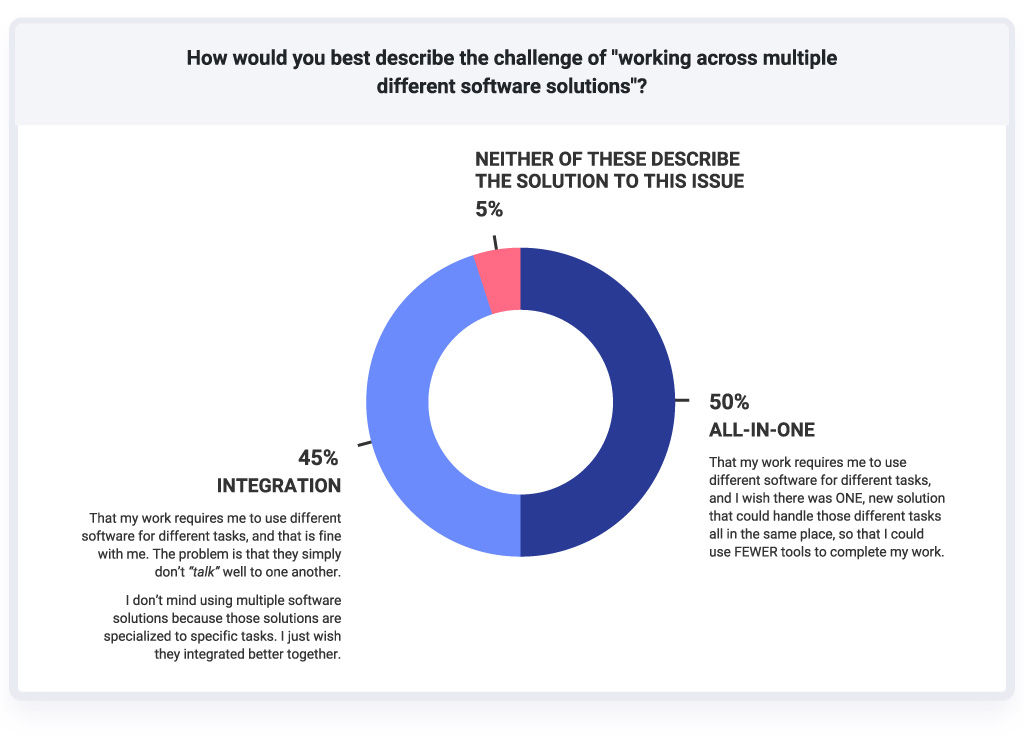
So, in a nutshell, a self-service BI integrated within your digital workspace will create a simplified daily workflow, allowing each team member to communicate with every stakeholder in a particular task. Thus, the problem-to-solution time is reduced drastically.
Single Version of the Truth
As opposed to spreadsheets, which lead to nothing else but complexity and delays, self-service BI data flow stays consistent and effortless. With self-service BI, data is updated constantly. This allows decision-makers to have access to a single version of the truth all the time. There are no misinterpretations or errors. There are only facts.
Such universally accepted data brings everyone in your company to the same page. Decisions are taken based on what everyone sees, which reduces the time for explanations and micromanaging.
As a result, this creates a transparent work environment and enables a single place for collaboration. You no longer need to spend time in team status meetings and micromanaging. Instead, focus on spending more time as a mentor and proactively thinking about the business.
Competitive Advantage
Implementing a unified data source into your work management solution will save you time, effort, and, most importantly, frustration. Not only will you make faster, smarter, and more accurate decisions compared to your competitor, but you will also be the preferred employer for experts. A transparent environment fostering straightforward workflow, collaboration, and recognition will always be preferred to the alternative.
Project management
Seamlessly manage tasks, teams, and projects of any complexity from start to finish.
Use Template →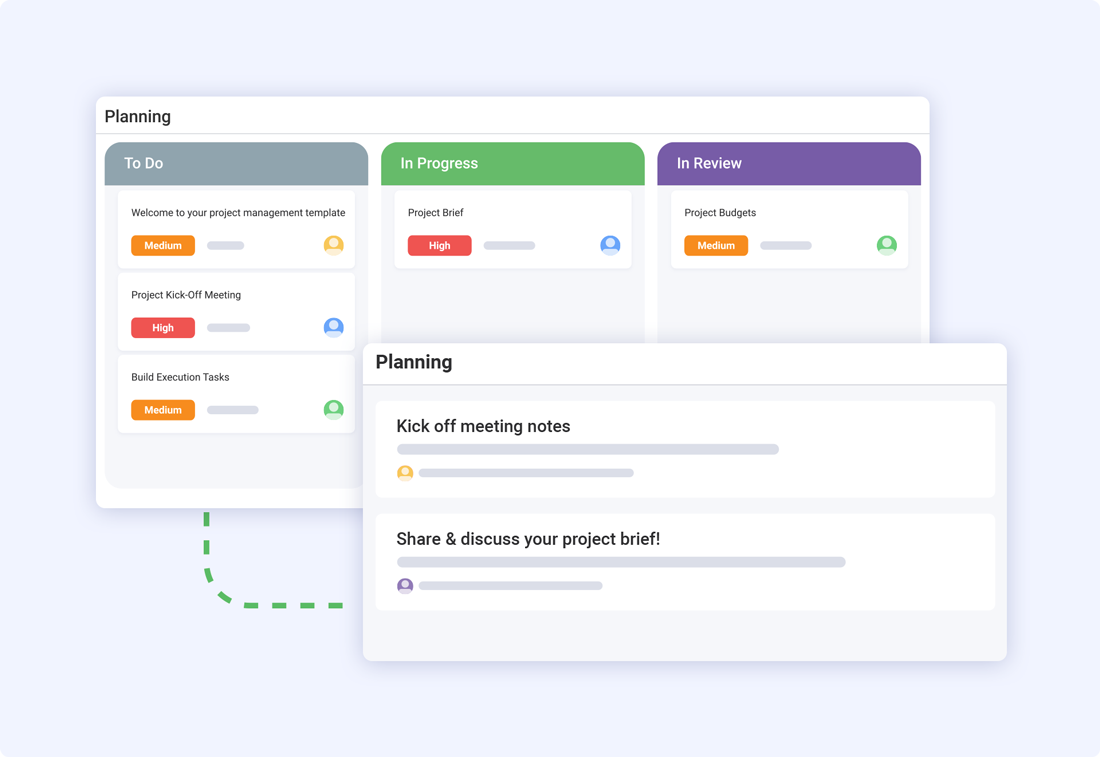
How to Set a Self-Service BI Strategy?
For a successful self-service BI deployment, you must have a good strategy. Of course, each business model, industry, and niche require a different strategy for implementing self-service business intelligence. Regardless, you must follow some universal guidelines if you want your Self-Service BI to bring out the best in your teams and business.
Define Clear Goals
The self-service BI strategy must have a clear goal. Of course, when discussing self-service business intelligence integrated within your work management tool, the obvious goal is to allow stakeholders to make informed, data-driven decisions.
Still, consider the KPIs you will follow and additional goals you may want to explore. For example, you may integrate this solution to increase your team’s motivation. You can also do it to raise productivity and reduce lag and stress.
Knowing your goal will allow you to determine whether your implementation strategy is working.
Set Roles and Responsibilities
Setting roles and responsibilities for different users is also one of the best practices for self-service business intelligence. You decide which key business users will have access to your BI solution, what data they can view, what actions they can perform, and which functionalities they’ll be able to use. Consider giving all your employees access to relevant data, as this will help boost the team’s motivation and productivity.
Help in User Adoption
As with any new software, users need time to get used to it. Operators must learn how it works and what its unique features are. Bearing this in mind, you must develop some introductory and training materials for your team. This will be very useful for your team members new to the analytics topic.
Monitor Use and Adjust as Necessary
Monitor how well different teams adjust to utilizing the self-service BI. Ensure that each team member can call on the data they need. Moreover, observe whether they follow security protocols and other measures implemented to keep your data safe. Naturally, some less tech-oriented teams will have a harder time learning the ins and outs of the new tools. Don’t ostracize them. Instead, provide them with additional training.
Empower Employees to Tell Stories With Data
If data isn’t understood and it isn’t convincing, no one will act on it. Therefore, nothing will change. That is why the data-driven storytelling technique is so powerful. It allows users to utilize the insights provided by their BI tools to tell stories so that others can understand what the data tells us.
Choosing the Self-Service BI Tools
To gain all the benefits we already mentioned early on, you must choose your Self-service BI tools carefully. Luckily, there are some common features and solutions that the best tools on the market provide, regardless of your organization’s unique needs.
Data Connectors
Modern BI software lets users connect seamlessly to many different data sources. Then, it combines the data in one place for comprehensive analysis. Data sources may include:
- Azure Synapse
- Google BigQuery
- Box
- Sharepoint
- Google Drive
- One Drive
- Microsoft Analysis Services
- Microsoft SQL Server
- CRM
- Many more
Some embedded analytics platforms also offer a feature called “in-memory data source,” which lets users directly connect to a data source the software doesn’t support out of the box.
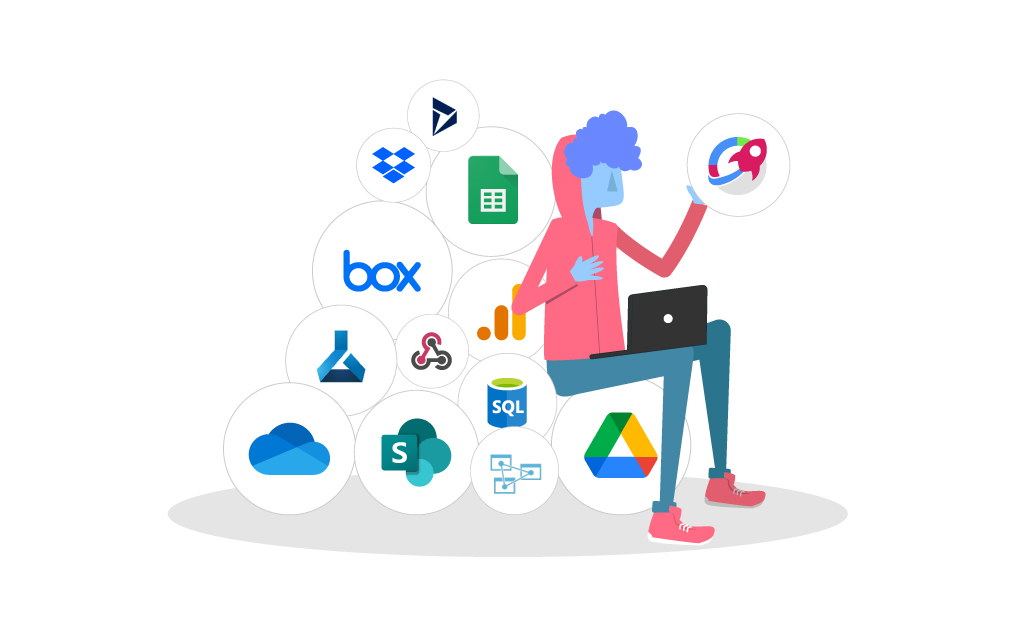
Intuitive Interface
Professional self-service BI tools will ensure users can easily select data fields from the tables within the data source by simply dragging and dropping them into separate sections. This will instantly build beautiful data visualizations. The more effortless the process is, the more data-driven solutions your team will implement into their daily work.
On-Demand Results
The most effective self-service BI tools allow users to create, analyze, and share their dashboards on demand. This means users should be able to work from anywhere, all the time. So, look for tools that offer a great mobile experience and even an app. This way, executives, managers, and even employees can easily call on information, no matter where they are, and give competent, data-driven feedback to any question or query.
Collaboration
In the same spirit, your self-service BI tool should focus on collaboration. Sharing data and having a single truth will ensure your workflow goes smoother and your results are better.
Predefined Dashboard Templates
For non-tech and non-BI experienced users, having templates is a must. So, your tool must offer predefined dashboard templates if you want your self-service BI to benefit your entire company. This way, a marketer, for example, can use a pre-designed template and populate it with the data sources they need instead of trying to figure out how to design their dashboards from scratch.
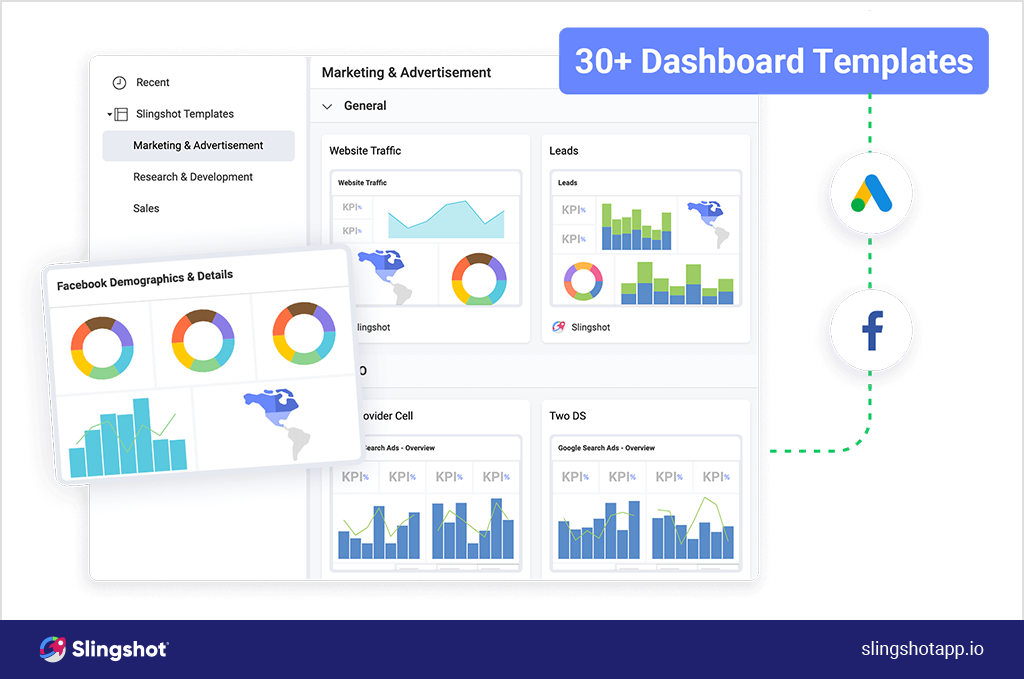
Scalability and flexibility
Similarly your self-service BI tool must be flexible, customizable, and effortlessly accommodate your business growth. As your business grows, so will your data volume and users. Thus, you must be able to scale your operations, and your self-service BI tool must be capable of meeting your needs.
Furthermore, the more people use the tool, the more they will need more customizable dashboards. There is no such thing as one-template-fits-all in data analytics. So, while it’s mandatory for a good self-service BI tool to offer templates, it must also be flexible enough to allow advanced users to create data visualization as they see fit.
AI-Powered Solutions
Implementing AI into your self-service BI will enhance not only your decision-making but the entire workflow as well. All-in-one AI tools allow you to quickly and efficiently create tasks based on data insights. Moreover, AI can make predictive assumptions based on rigorously analyzed data patterns.
Thus, your decision-making will no longer be reactive but become proactive instead.
Stable and affordable pricing
Finally, as a manager, you already value predictability and stable solutions. Unfortunately, many SaaS solutions have tiers, plans, and pricing based on users, data volume, and anything in between. While this is not a huge problem for big brands budget-wise, it limits scalability and affects financial decisions and projections.
Thus, the best self-service BI tools will have stable, affordable, and predictable pricing.
Integrated Productivity Flows
Without a doubt, the most important feature of your self-service BI should be its capability to integrate all the apps your team already uses under the same roof. Connecting your apps ensures an uninterrupted flow between all tools your teams use – automatically get your tasks, chats, projects, and more in the same place.
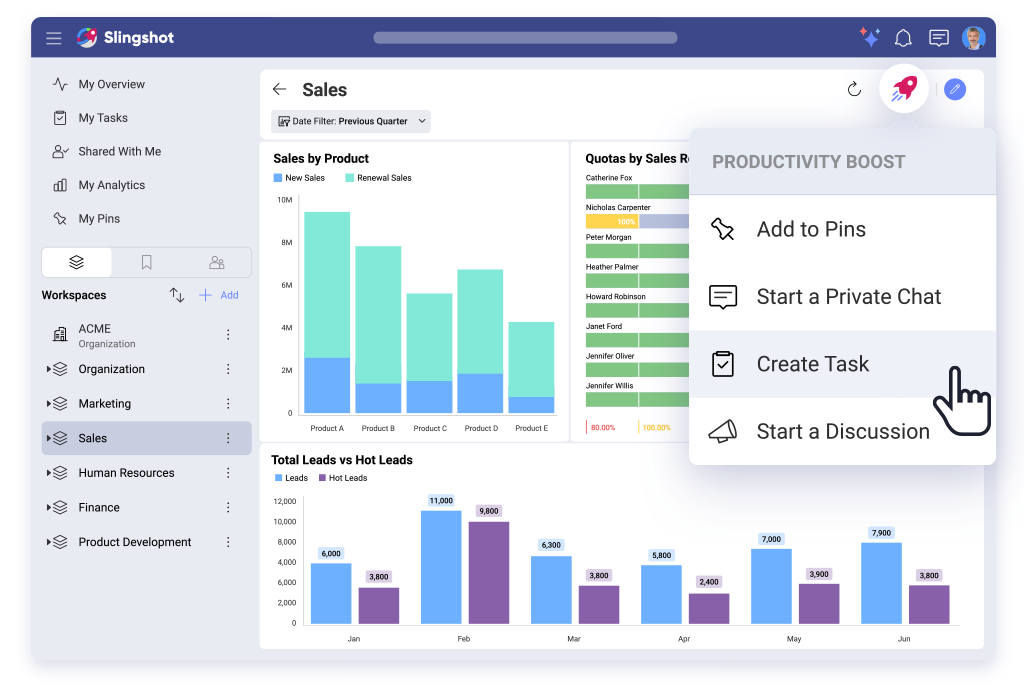
Tie together information and documentation between departments and harmoniously coordinate and collaborate with teammates. Go beyond data analysis by having a full BI tool plus project management, content integration, goals, strategies, etc., that produce extraordinary results that drive business growth.
This is why Slingshot is the best choice, regardless of your business industry and niche.
Is Slingshot the best Self-service tool on the market?
In a word – Yes! Slingshot is more than just a self-service BI tool. It’s a data-driven, AI-powered BI engine incorporated within a state-of-the-art digital work management tool designed to help you make better, more informed decisions faster.
Slingshot is the only work management platform that empowers you to eliminate data silos, unify business intelligence, and gain the immediate insights needed to optimize processes, enhance collaboration, and drive sustainable growth.
Take a look at a specific example where Slingshot can streamline the entire work process, drive smart business decisions, and use data to achieve better results:
Related Articles
Ready to grow your business 10x with AI decision-making?
Request a Free Demo of SlingshotSHARE THIS POST




